“False truffle” is one of those phrases that has become very difficult to define thanks to the twin forces of casual usage on the one hand and taxonomic reorganization on the other. The short version is that there are truffles, which are all members of the genus, Tuber, and then there are other fungal growths that look like truffles to varying degrees but aren’t. Some are edible, but most are not. Which species count as false truffles depends on who you ask[i][ii].
So let’s explore these False Truffles, shall we?
Separating the True from the False
True truffles are members of the genus, Tuber. Their fruiting bodies are entirely underground and depend on animals to dig them up and disperse their spores. The reason truffles have such a delicious taste and enticing odor is they want to be found and eaten. There is at least one related genus whose members are considered “truffle-like” and are sometimes included in lists of false truffles, but belong to a completely different phylum, making true and false truffles about as closely related as humans and starfish.
Tuber is in the phylum Ascomycota, as are morels. Most of the various false truffles are in Basidiomycota, along with most familiar edible mushrooms.
Because “False Truffle” isn’t a technical term, definitions vary, so it’s hard to get a compile, definitive list of all false truffles. But it’s reasonable to say there are at least three groups.
The “Hymenogastrales”
These get scare-quotes because the name refers to a whole taxonomic order that no longer exists—its members have been folded into the Agaricales order, where their several genera share the Hymenogastraceae family with a number of gilled-mushroom genera, including both Psilocybe and Galerina.
According to some, this is the groups that the phrase “False Truffle” refers to. Like true truffles, their fruiting bodies are entirely underground and have lost the ability to release their spores, so these fungi, too, depend on animals to dig up and eat them. But in this case the animals in question are usually rodents, and the fruiting bodies are mostly unpalatable to humans. Also, unlike true truffles, these fungi are mycorrhizal, meaning they live in mutually-beneficial partnership with tree roots.
Subterranean Puffballs
Puffballs are not a taxonomic group, either—the word applies to fungi whose fruiting bodies are entirely enclosed until they rupture, releases the spores in puffs of powder. While the best-known puffballs are edible, there are also some poisonous or unpalatable species with puffball-type fruiting bodies. Some of these begin fruiting partially or wholly underground. The fruiting bodies do emerge to rupture and release their puffs. Some Sclerodermas, otherwise known as Earthballs, follow this pattern, as do some Pisolithus species, also known as dyeballs.
These semi-subterranean puffballs are structurally and functionally very different from truffles, but can be easily mistaken for true truffles when young, until they are cut open.
Magic Truffles
Magic “Truffles” get scare-quotes because they aren’t fruiting bodies at all. They are hard nodules produced by the mycelium of some Psilocybes that can survive drought or other problems and sprout new mycelium when conditions improve.
Introducing the False Truffle Genera
Here is a list of at least some of the genera that contain species sometimes referred to as false truffles.
Psilocybe
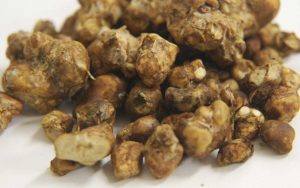
Some, though not all, members of this genus form truffle-like structures called sclerotia that they can use to survive drought and other problems[iii]. These structures store energy and protect living but dormant hyphae (fungal threads). When conditions improve, the sclerotium can sprout new hyphae that grow into a new mycelium. Sclerotia are not fruiting bodies, though, and thus are dramatically different from true truffles and all other false truffles.
Psilocybe sclerotia are famous because they are psychoactive—they are usually referred to by users as magic truffles or philosopher’s stones. But many other fungi produce sclerotia, many of which don’t resemble truffles at all.
Choiromyces
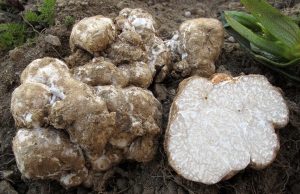
Choiromyces is a small genus related to Tuber and quite similar to it[iv], except for the microscopic structure of its fruiting bodies and spores[v]. Some of its members are commonly eaten by some people and considered poisonous by other people[vi]. The edibility of others is unknown. Some can be mistaken for certain true truffle species, and may be sold as them, fraudulently.
Scleroderma
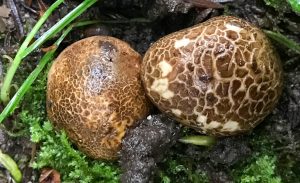
Scleroderma is a smallish genus of mostly-identical, thick-skinned puffballs[vii]. As a group, they are often called earthballs or pigskin puffballs. Although they are often found fruiting above the soil surface, like other puffballs, they can also be found partially or completely buried. They are not edible, and at least some species are poisonous[viii].
Pisolithus
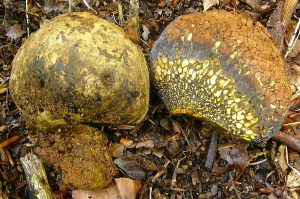
The Pisolithus[ix] species were separated off from Scleroderma and, like them, are mostly inedible, possibly poisonous puffballs that can be partially buried when young. At least one species is useful in making dyes and is thus called the dyeball.
Rhizopogon
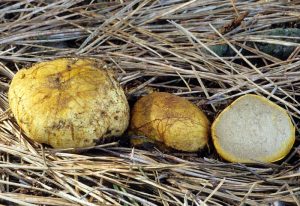
Rhizopogon[x] is another puffball genus where fruiting bodies form at least partially underground, though they tend to emerge as they grow[xi]. They do look very truffle-like. And, almost like truffles, they are often eaten by animals, and their spores can be dispersed through animal droppings. Members of this group are edible by humans, and while many are considered bland or unappealing, there is a Japanese species that is considered a delicacy.
Hymenogaster
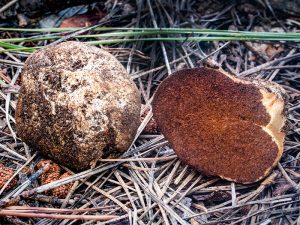
These fungi[xii] could perhaps be called true false truffles in that they are underground fruiting bodies with spores dispersed by animals, like truffles. But many are inedible by humans, of unknown edibility, or safe but highly unpleasant to eat[xiii]. There may or may not be other “true false truffle” genera; our sources are unclear on this point.
References:
[i] (n.d.). The False Truffles. Trufamania
[ii] (n.d.). Hymenogastraceaea. MycologySt.art
[iii] (n.d.). Magic Truffles. Wikipedia
[iv] (n.d.). Choiromyces. Wikipedia
[v] Wood, M., Stevens, F. (n.d.). California Fungi—Choiromyces alveolatus. Fungi of California
[vi] (n.d.). Choiromyces venosus (Fr.) Th. Fr. Trufamania
[vii] Kuo, M. (2011). The Genus Scleroderma. MushroomExpert
[viii] (n.d.). Scleroderma citrinum Pers.–Common Earthball. First Nature
[ix] (n.d.). Pisolithus arrhizus (Scop.) Rauschert—Dyeball. First Nature
[x] (n.d.). Rhizopogon. Wikipedia
[xi] (n.d.). Rhizopogon luteolus Fr. & Nordholmt—Yellow False Truffle. First Nature
[xii] (n.d.). Hymenogaster. Wikipedia
[xiii] Rockefeller, A., (2009). Observation 17623: Hymenogaster Vittad. Mushroom Observer




